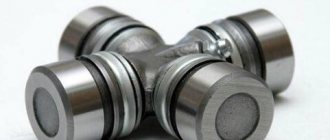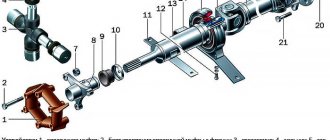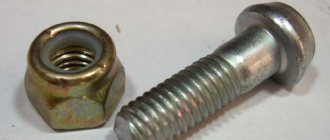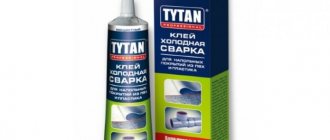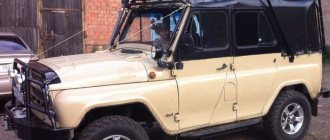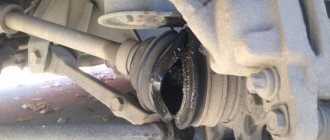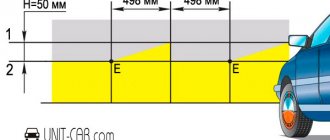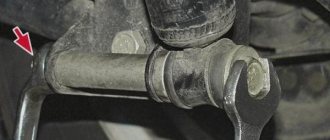Instructions for making a cardan for a car model.
Good day everyone! Today I will tell you how to make a universal joint for a car model
To start making the cardan, take a tube of the diameter we need
Then we drill it on a drilling machine. I took a drill with a diameter of 1.5 mm (If you make a larger cardan, then take a drill with a larger diameter)
Next, in a vice, use a file to cut out the “ears”
We cut out a square (It’s not for nothing that the square was made of brass, since you don’t have to be afraid that the cardan will rust)
We connect all the parts of the cardan together
After fitting, we insert the pins and solder them so that they do not fall out. The cardan works at an angle of up to 45 degrees and does not hit.
Instructions provided by: automodel laboratory “Wheels of History” Thank you all for your attention!
The simplest thing is a cup and a fist
13 mm You can’t buy such a cardan everywhere, and even with such dimensions the price will be at least 100 rubles; I only need 6 cardans for an amphibian. and now we are making 10 models for competitions (we will post all of them here later). Through simple arithmetic calculations, we find that (6*10*100) only 6,000 rubles are spent on cardans. But for us it’s not a penny. So I think your “bicycle” is not appropriate here
Let's continue minus!
This is basically what we do) I made the instructions a long time ago and it was intended for beginning car modellers. If I had described it to them exactly as you wrote, then their hands would have become dry due to the lack of the necessary tools and skills. Next week I will start sharpening the cardan shafts for the Ford GPA amphibian, it will be possible to make detailed instructions. But will there be any point in doing it if experienced modellers already know this?
Source
Non-traditional hinges
The cylindrical connection found its original application in the manufacture of furniture products. Doors, blinds, and decorative partitions assembled from slats became available with the advent of woodworking cutters on the market. Having a small machine will help you easily make a hinge joint with your own hands.
A pass with an edge cutter creates a rough groove on one of the narrow edges of the wood strip. It is then passed through with a groove cutter to obtain a shaped groove.
A spike is formed on the other side. It is obtained in two finishing passes. A shaped edge cutter will help you make a cylindrical hinge joint. After rounding the edges, the rail takes on its finished form.
By alternately fixing the corresponding cutter on the milling machine and passing a wooden blank along it, hinge joints are made. By assembling tongue-and-groove slats, a flexible sheet material is obtained that, depending on the width of the parts and the density of the joints, can be rolled into a tube up to 15 cm in diameter.
Pipe joints in their design have much in common with CV joints: two spherical cages, between which balls are located in the grooves, held by a separator. The use of a fluoroplastic ring ensures radial sealing of the connection. The inner ring is connected to one end of the pipeline, the outer - to the other.
Thus, both pipelines are able to rotate freely in all directions relative to each other. Mutual fixation of the clips is ensured by the balls located between them.
Draining and loading elements of pipelines operate under conditions of frequent changes in the direction of supply of the transported substance. To speed up redeployment on such highways, a hinged connection of pipes is used. It can be used in the oil, petrochemical, food or gas industries.
Microcardans
Good afternoon, colleagues! Tell me the design for making micro cardans F 3-5mm motor-shaft connection for a plastic model (length 300mm, width 30mm) All store-bought ones are too bulky, I know about homemade designs for ships of “normal” sizes, but with such dimensions there are problems with manufacturing accuracy . I hope this information will be useful to many who are trying to build running micromodels of ships.
I use springs. For small ones, springs from fishing nods are well suited. I installed springs from old furniture hinges on a meter-long snail boat with DPR-52.
You can also make the shaft tips in the form of forks that fit into one another. The springs are, of course, better, but the fork cardan leaves the possibility of disassembling the unit.
I once made one from a telescopic antenna and selected it by diameter. But he fastened it tightly and soldered both the daywood and the engine shaft.
Konstantin, I made “cardans” for myself on the F4-A based on the cables from the speedometer with a twisted top layer.
The cardans turned out to be simply gorgeous in terms of noiselessness, you can’t hear them at all! And unlike springs, I’m not afraid of them that they might curl up when winding.
If I ever make another copy model, I will use this design again.
The only caveat is that the bend of the cardan should be as minimal as possible, otherwise losses increase greatly, but this depends on the thickness of the cable used (mine is about 2.3mm, I don’t remember exactly).
And for such a small model as 300mm, it is quite possible to twist another layer from the cable, the diameter will be about 1.5mm, it should work very well with a length of up to 20-30mm. But you must first make one for testing and check how it will withstand the jamming of the shaft with the engine being used.
PS Funny photo, the traction and mounting location of the machine was redone a long time ago.
Source
Do-it-yourself Renault Duster driveshaft repair
- 1 Crosspiece as the basis of the cardan
- 2 Signs that the Duster driveshaft is failing
- 3 Symptoms of damage
- 4 Duster driveshaft
- 5 What affects the service life of the unit
- 6 Repair
According to statistics, when there are problems with the driveshaft, the root cause most often becomes the spider. It is the basis of the hinge mechanism for interacting with the cardan drive. Thanks to this system, mating elements can rotate at an angle relative to each other.
The size of the cross is 19x55.2. Even a new factory part often has a manufacturing defect, which is easily identified in the store. If you hold it with your fingers at the opposite ends and shake it, then it should not play (wobble). If there is movement, then there is a marriage. Such a part will not last long even with gentle driving.
Signs that the Duster driveshaft is failing
The first thing that will indicate a malfunction is strong vibration coming from under the bottom. The breakdown is also expressed in characteristic sounds, but you can’t always hear them from the interior - good sound insulation does not play into this.
The higher the speed, the more noise and vibration appear. The service life of the shaft itself is very high - up to 500 thousand kilometers. But more often it is not the pipes themselves that suffer (only in case of imbalance), but the joints. It is worth starting with a preliminary and thorough inspection.
It may turn out that the whole problem is that the fastenings of the hanging clamps have become loose. Crossings, for example, can wear out even after fifty kilometers. In such cases, the car owner’s expenses will be minimal, and repairs in our car service will not take much time.
Symptoms of damage
Elements of Renault Duster 4x4 can withstand significant loads. However, aggressive driving, lack of protection and impacts with the ground can damage the driveshaft itself and the spider. If the part can be replaced independently, then the shaft will have to be changed at a car service center. A faulty crosspiece can be determined by the following signs:
- vibrations and rattling;
- knocking, grinding noise while accelerating;
- engine vibrations when driving in any gear.
If you have experience in car repairs, then there will be no problems with replacing a damaged part.
Duster driveshaft
Renault Duster is equipped with two driveshafts, which corresponds to the number of axles. This element is an open type. The cardan shaft has splined joints and hinges. Various cardans are installed on the front and rear axles. Therefore, when replacing elements, this fact must be taken into account.
Cardans have the following characteristics:
- Dimensions. A shaft with a shorter pipe is installed on the front axle.
- Number of connections. In some modifications of the French crossover, an intermediate shaft with separate clamps and crosspieces is installed at the rear.
- Design. More often, a hollow shaft is installed on the front axle, and an all-steel shaft at the rear.
- Features of components. Each cardan uses its own (different from each other) crosspieces.
In essence, the cardan consists of two different-sized pipes made of steel and having thin walls. Between these elements there is a hinge. There are flanges on the sides of the steel pipes. With the help of the latter, the part is connected to the junction box and gearbox.
At the ends of the cardan there are also joints with two forks. One of them provides mounting with a pipe. The second fork is connected to the flange. A crosspiece with four needle bearings, which are responsible for the angular change when transmitting torque, secures both forks together.
What affects the service life of a node
The causes of breakdowns can be either trivial - for example, wear and tear due to wear and tear - or specific - the car owner lacks driving experience.
Among the most common reasons, experts highlight:
- collisions with obstacles at high speed, as well as sudden starts from a standstill;
- uneven roads (frequent driving on them damages the driveshaft several times faster);
- lack of lubrication at joints.
- The crosspieces, bearings, and seals are worn out.
Separately, it is worth mentioning the installation of the cardan after its failure. There is a risk in this regard:
- purchase and install defective, used or unbalanced parts.
- use the services of craftsmen who do not provide a guarantee for their services. The worst thing is if they are self-taught and have neither experience nor equipment.
Important! When purchasing a shaft or components through third parties, on the market or on the Internet, there is a serious danger of wasting money. The cardan can be installed and even work for some time, but soon a defect will definitely appear and instead of imaginary savings, you will receive additional costs and loss of time.
Repair
Repair work begins with determining the location of the breakdown. This must be done, since usually it is not the part itself, which is quite expensive, that breaks, but individual elements.
Initial examination
The initial inspection allows you to identify the place where the problem arose. To assess the condition of the cardan and crosspiece, the Duster must be installed on an overpass and raised on a jack so that the wheels can rotate freely.
During the initial inspection, you need to pay attention to the following aspects:
- current condition and tightness of fastenings;
- condition of bearings and seals (no visible defects);
- spline connection condition;
- presence of play at the hinges.
Duster universal joint
Renault Duster uses a crosspiece on its cardan, the dimensions of which are 19x55.2 (often written 55.5), of the following brands:
- GKN;
- GMB;
- Febest;
- Zekkert.
The 19×55 crosspiece relatively often has a manufacturing defect, the presence of which can be checked upon purchase. To do this, the part must be placed on a flat surface. Next, you need to take the cross with two fingers at the opposite ends and shake it. A similar manipulation should be carried out in relation to other parts of the part. The absence of play (the cross does not wobble) indicates that the product was released without defects.
Dismantling and repair
To remove the problematic part, you need to perform several steps:
- The locations of the driven shaft flanges and universal joint forks and electromagnetic clutch are marked. This makes it easier to reinstall the part. In addition, the marks help restore the previous balancing of the cardan.
- Using a 16mm spanner, unscrew the bolt that secures the hinge fork to the electromagnetic clutch.
- After turning the cardan, the remaining 3 bolts are unscrewed.
- The propeller shaft moves forward, after which the centering collar of the fork is removed from the flange of the electromagnetic coupling.
- Using a wire, the shaft joint is fixed to the coupling.
- Using a key set to “13”, unscrew the 2 bolts that secure the intermediate support bracket to the bottom of the car.
- Using a “16” wrench (an extension is required), unscrew the bolts of the front cardan fork. The fasteners secure the part to the transfer case.
- The part is moved to the side and the centering collar is removed. After this, the shaft can be removed.
Suzuki Jimny 1.8 › Logbook › Balancing the driveshaft with your own hands, project K1! )))
After installing the transfer case from the samurai, beats appeared at 60-70 km/h. The industrial cardan was cut and balanced at a specialized service center, but I forgot that it needs to be balanced with a spacer. To confirm my guesses, I simply unscrewed the rear cardan and, standing still, accelerated the car to 65 km/h, vibrations appeared as when driving... Because. Give the next 5 tr. The toad was simply strangling me for balancing, so I decided to look for methods of self-balancing! In the extreme, if it doesn’t work out, I’ll always have time to pay the money for balancing... If laziness is the engine of progress, then greed calls for learning new things))) There are several successful experiments on the topic of artisanal balancing on the website of microbes and a very educational film from Toyota, in principle there is nothing complicated about it, I decided to go there and create a miracle myself))) Here’s a movie about the gimbal, watch from 23:55, I watched the whole thing:
So, first we need to build a vibration force meter for the collective farm.
Yes, this will be our meter))) You can just glue a twig in the center, but how can you store it later, because I’ll tear out the diffuser somewhere, so I glued a nut into which a long bolt will be screwed. Everything seems clear here, but how will it measure vibrations? Everything is simple, download the program here: Oscilloscope program And connect the connector to the microphone output, change the settings, everything is simple and clear. The main thing during measurements is to measure from start to stop, then you can save a file with a graph and a text format, where the vibration forces will be specified in numbers.
Do-it-yourself driveshaft repair - features and equipment
Description and features of do-it-yourself driveshaft repair: purpose of the device, imbalance, weak points, repair tools. Video about the operation of the cardan shaft.
“Listen, your cardan is knocking... Take it in for repairs, otherwise things will end badly,” was the recommendation the heroine of the film “Moscow Doesn’t Believe in Tears” received from her boyfriend. However, a car enthusiast can often cope with problems with the “cardan”, scientifically called a driveshaft, on his own, without resorting to the help of a workshop. Why is this unit so important and what is needed to repair it in “garage” conditions - more on that later.
CV joint malfunctions
The internal CV joint is one of the main elements of the transmission in a car, and therefore is made of high-quality materials (not counting fakes).
Usually the shelf life of these parts is long, but it often turns out that wear occurs much earlier, this happens even with new cars. Causes of CV joint wear:
- Insufficient quantity of lubricant or its poor quality.
- Poor quality of material in the manufacture of CV joints, use of fake and defective parts.
- Penetration of foreign objects and water due to the fact that the boot has failed.
- Poor road surfaces and careless driving on these roads.
- Late diagnosis and replacement of spare parts.
Primary diagnostics can be carried out by the driver himself, without resorting to the help of a car mechanic, through a superficial inspection, thanks to which damage to the boot can be identified. For a more detailed inspection, you will have to disassemble the hinge; an overpass, a hole, or just a jack will help with this. It is not difficult to diagnose the CV joint yourself.
Typical hinge failures:
- Extraneous sounds (crunching), they intensify when turning, accelerating, overcoming barriers. The balls are so worn that they move smoothly along the recesses.
- Lack of lubrication inside parts.
- Shaft clearance. In order to understand whether this is so, you need to take the axle shaft and move it; if there is a defect, you will immediately find play in the working side of the CV joint.
- Foreign objects that fall from the road surface.
To determine the sound of a faulty outer joint, you need to select a flat surface, turn the steering wheel as far as possible and move sharply, thereby putting a load on the joint, and if it is really faulty, you will hear a familiar noise
It is important to determine which side the crunch is coming from.
Failure in the internal hinges is diagnosed a little differently. Here, on the contrary, you need to find a bad road with potholes and drive along them. If the CV joint rattles, it means a breakdown has occurred. There is also a way to diagnose a crunching internal CV joint. It is necessary to load the tail of the car so that the front rises and the axis of the internal hinge bends as much as possible. The main sign of a breakdown is a crunching sound when moving. It is not recommended to drive with the rear of the car loaded, on a regular basis, check the shock absorber springs.
The third way to recognize which side the “grenade” is knocking from is the following algorithm:
1 — align the car wheels evenly.
2 - lift any one drive wheel with a lift.
3 - put the car on the handbrake and remove it from gear.
4—move off smoothly (the suspended wheel will begin to rotate).
5 — slowly depress the brake pedal, thus creating a natural load on the “grenade”. If there is a malfunction in one of the internal CV joints, sounds will immediately appear in the faulty part of the machine. If there is no defect, then the car simply starts to stall.
6 - Turn the steering wheel as far as possible. Slowly depress the brake pedal. If there is a malfunction, the crunching will continue. If there is a breakdown of the CV joint on the other side, then additional sound will increase. You can fully understand that the failure is in the CV joint if jerks appear at the beginning of the car's movement. It is preferable, of course, not to bring the car to a state of complete depreciation and carry out a monthly check. When hanging a wheel and checking CV joints, follow the safety rules, do not forget to put the car on the handbrake, and it is best to use a wheel stopper
Pay attention to whether you remember to set the gear to neutral, turn off the engine, wait until the wheel comes to a complete stop before placing it on the surface
Purpose of the cardan shaft
In principle, cars with front-wheel drive do not need a cardan. Their engine transmits speed to the drive wheels through completely different transmission elements. But cars in which the rear wheels are driven or all four are driven are nowhere without a cardan.
In the first case, this part connects the gearbox with the rear axle gearbox, and in the second, there are usually three such elements at once. One of them interfaces two gearboxes: a gearbox and a transfer case, the other two transmit speed from the latter to the axles.
By the way, the car in which, according to the womanizer from the film “Moscow Doesn’t Believe in Tears,” the driveshaft was knocking, was a rear-wheel drive VAZ 2103.
The design of the cardan shaft and the principles of its operation
We are looking for two authors for our site who are VERY well versed in the structure of modern cars.
Contact by mail
A driveshaft is an alternative to a drive shaft used on some rear-wheel drive and all-wheel drive vehicles. This transmission element is a mechanism that, through connection with the gearbox, transmits torque to the drive wheels of the car. In fact, this type of torque transmission is partly outdated, but is still used on a number of vehicles, for example, on SUVs of the UAZ brand, well-known to many. We will talk in more detail about the operating principles, design and main problems of the driveshaft in the article below.
It was noted above that the driveshaft is a torque distributor between the axles and half shafts of some cars. Before the advent of constant velocity joints (otherwise known as grenades), the “cardan” was one of the most popular transmission elements of all vehicles without exception. However, due to the design features of front-wheel drive cars, the driveshaft was forced out of their structure, and the previously mentioned grenades came to replace it. Despite this, the “cardan” is still used in the design of many rear-wheel drive and all-wheel drive cars today.
A standard type cardan mechanism can be represented in the structure of a car by two elements:
- The front driveshaft, which often extends on both sides of the gearbox and each part interacts directly with the axle shafts (wheels);
- And the rear driveshaft, which is either also connected directly to the gearbox, or extends directly from the front of the mechanism through a special distributor (middle “cardan”). The rear driveshaft has a significant difference from the front one, namely, a special structure, which involves the use of a thin-walled pipe that transmits rotation to the axle shaft through connection with the previously noted nodes. In the case of using a front “cardan”, a similar approach is not required, since the drive mechanisms are connected directly to the wheels.
Front driveshaft
Rear driveshaft
If with the rear driveshaft everything is extremely simple - it consists of a thin-walled pipe, hinges and a connector with the gearbox, then with the front driveshaft the situation is slightly different. This part of the mechanism in its standard version has the following structural elements:
- suspension bearing (less commonly, other torque distributors);
- double hinge necessary to transmit rotation to the axle shafts;
- one or more sliding forks that distribute rotation between the axle shafts or axles after receiving it from the gearbox;
- intermediate seals and protective components (seals, gaskets, etc.);
- fasteners of parts.
Considering the principle of operation of any part of the driveshaft as simply as possible, it is worth highlighting three basic stages of its operation:
- A thin-walled pipe or sliding fork connected to a source of rotation (gearbox) on one side receives this same rotation from it;
- Connecting to the axle shafts on the other side, these elements transmit torsion directly to the wheels;
- In the process of implementing the two previous stages, it is possible to correctly distribute torque between the axles through the use of some bearings, hinges and similar elements of the device. In addition, the mentioned joints in the driveshaft design are used to transmit rotation at an angle. The greatest effect and efficiency from such a rotation transmission is achieved in the angular range of 0-20 degrees. Of course, most “cardans” can transmit rotation even when the wheels are turned more, but in this regard they will in any case be inferior to the grenades of front-wheel drive cars.
Can the cardan knock?
Some car enthusiasts, analyzing the episode from the mentioned film concerning the alleged malfunction of the driveshaft, express their thoughts on this topic in the comments:
In truth, the operation of the cardan is indeed accompanied by vibration and various sounds. In modern cars, highly effective noise and vibration insulation products cope perfectly with these unit shortcomings. However, not always.
Cardan imbalance
If a car's acceleration is accompanied by strong vibration of its body, then this is a sure sign of an unbalanced driveshaft. A malfunction of this kind can damage not only this unit, but also the entire machine, which can lead to costly repairs.
After all, an unbalanced cardan increases wear on parts such as the gearbox driven shaft and the gearbox shank flange bearings. Moreover, a malfunction of the shank can cause an emergency while driving, the consequences of which are unlikely to please the motorist.
Well, you can find plenty of reasons for imbalance. Most often, the following manifest themselves:
Balancing the driveshaft
Vibration in the car cannot be ignored; at the first sign of such a problem, you need to start fighting it. For example, by balancing the driveshaft. This expression is widely known among car enthusiasts.
You can “adjust the cardan” yourself, even without having the expensive equipment used by auto repair shops for such work. But for those who undertake this process, it is advisable to at least approximately understand its essence. In general, balancing is not particularly difficult, although it can take a long time.
To implement this, you will need an inspection hole from which you can get to the cardan of the car. A number of weights with different masses are also useful, used when establishing wheel balance. Electrodes or small lead elements are also suitable as counterweights. The cardan balancing itself is performed as follows:
Violation of shaft geometry
The most durable components of the cardan are its cylinders, made of steel that can withstand significant loads. As a rule, such parts are designed to last about half a million kilometers. But these elements can also be deformed, for example, when the machine overcomes some kind of unevenness or due to the breakdown of the hinges located at their edges. Strong vibration when the car is moving, coming from below, is a sure sign of problems with the cardan.
Some “wizards” advise leveling out dents on the cardan using a sledgehammer. However, insufficient quality of such work can also lead to rapid failure of the crosspieces. Therefore, instead of a severely deformed cardan, it is recommended to immediately install a new one, which should then be balanced. The price of this assembled unit starts from about 1300 rubles.
Evolution of the cylindrical hinge
A unit of two cylindrical hinges with perpendicularly placed axles is used in a cardan transmission. It is named after Gerolamo Cardano, who described it in the 16th century.
A cylindrical kinematic pair was invented by the English physicist Robert Hooke and is used to transmit torque. The uninterrupted operation of the unit is ensured by the obligatory fulfillment of the condition of alignment of the parts of the drive shaft. Otherwise, under certain loads, the hinge joint begins to collapse. If the movement of parts is out of alignment, it is advisable to use a cardan with two crosses. This method is used if the torque is transmitted along axes located at an angle. Adding a crosspiece increases the number of degrees of freedom, relieves the load on the axles and forks, and prevents their destruction.
Weak points of the cardan
Most often, joints, crosspieces and bearings break on the propeller shaft. Mainly due to wear and tear. As a rule, the listed parts are designed for a mileage of 60-70 thousand km, but it is likely that it will be less. This value is influenced by:
Sounds or vibrations that are unusual for a working driveshaft indicate problems among its constituent hinges, bearings and crosspieces. Especially if at the start of the trip or when changing speeds there are knocks or clicks.
If the mentioned components of the propeller shaft are worn out, it is recommended not to repair them, but to replace them with new ones. Moreover, such products are quite easy to install and are relatively inexpensive. The approximate prices for them are as follows:
A car enthusiast with the necessary skills can replace such elements of the driveshaft independently. For those who are not “specialists” on this topic, it is better to entrust the process to car service specialists.
Operating principle of the double cross
The double cross allows not only changing the angle between the axes of the shafts, but also shifting them in height. Allows you to smoothly transmit torque between shafts, the axes of which intersect at angles reaching 40-45°. Double crosspieces of the cardan shaft allow you to work at large angles, which during operation have an intensive change in working length. Reduce transmission vibration levels by evenly distributing loads at maximum suspension travel. They help avoid biting the cardan crosspieces during large suspension lifts and severe bending.
Available for order on our website:
Rear propeller shaft UAZ 3162, 3163 Patriot with double cross and corrugated cover “ExpertDetal” at the link
Rear propeller shaft UAZ 3163 Patriot with double cross and corrugated cover, electronic control system “ExpertDetal” at the link
Rear cardan shaft UAZ 452 4-speed. Gearbox, hybrid. axle and front UAZ 3163 Patriot with double crosspiece, electronic RC “ExpertDetal” at the link
Front driveshaft UAZ Simbir, Hunter, Patriot 5th century. Gearbox with double cross and corrugated cover "ExpertDetal" at the link
In the spline joint and crosspieces of the propeller shaft, lithium-based grease is thickened with lithium oil “12 HYDROXYSTEARATE”, with the addition of:
antioxidant (preservative that inhibits oxidation); anti-corrosion agent; anti-seize agent. Thanks to these additives, the lubrication of the crosspieces is durable and has repeated effects. This grease can replace calcium-based grease and sodium-based grease, and can be used to lubricate bearings of aircraft, automobiles and other mechanical equipment.
Spline Coating:
Rilsan (RILSAN) is a polyamide based on components of plant origin. Polyamide contains no catalysts, hardeners, or solvents, which makes it possible to obtain coatings with excellent properties.
Depressurization of hinges
Another problem typical of a cardan is the depressurization of the protective shells of the ball joints. When such a casing wears out, a hole forms in it, through which transmission oil can spill out. If the amount of this lubricant is insufficient, the joints will not be properly lubricated, which will lead to rapid wear due to increased friction.
Traces of oil under the ball joints of an idle car indicate a breakdown that can be corrected by replacing leaky covers with new ones. Prices for such protective covers start from 120 rubles.
Cardan Repair Tools
On the modern market there are many offers for the sale of equipment for repairing driveshafts. It is mainly designed for car repair shops, but private car enthusiasts can also install some device from this series in their garage if they wish. For example, for more precise balancing of the cardan or to facilitate the process of assembling and disassembling this unit.
Similar equipment includes the R-223 stand, designed for repairing not only cardan shafts, but also steering gears. During the modernization, this “workbench” received smaller dimensions and a reinforced tabletop capable of supporting a weight of up to two tons.
The device is equipped with its own backlight, as well as a perforated screen and a drawer for tools. The cardan to be disassembled is installed on a special stand, fixed with a vice, and the bearings are removed from the forks using a hydraulic press equipped with a pressure gauge. The price of the unit is about 136 thousand rubles.
If you need to express the vibration of the cardan in a numerical equivalent, then the Vibrocom-1 device working together with a computer will help. The sensors of this device are based on GY-61 MEMS accelerometer modules. The basic package of the unit includes two vibration transducers, a photoelectric phase angle detector, a USB unit, and a flash drive with programs. The price of the complex is 12 thousand rubles.
Autogur73 › Blog › UAZ driveshaft with double cross
With any type of suspension lift, due to the fact that the length of the spring remains unchanged, the angle between the frame and the spring increases. As a result, the angle between the steering wheel mounted on the frame and the axle mounted on a spring increases. This change in suspension geometry inevitably leads to an increase in the working angles of the universal joints.
Conventional driveshafts use joints consisting of two forks and a cross. Such hinges are also called hinges of unequal angular velocities, the reason for this is their nature of operation: if there is a bend in the hinge, uniform rotation of the driving fork, the driven fork either lags behind or overtakes the leading one.
To compensate for this effect, when assembling cardan shafts, the pipe forks are placed in the same plane, then during operation mutual compensation occurs: the work of one hinge is compensated by the work of the second. However, this is only true when the hinges operate at the same angles. When conquering off-road conditions, the driveshaft inevitably bends the joints, which often exceeds the optimal angle on the transfer case side. In this case, we get uniform rotation at the input and uneven rotation at the output. In turn, this leads to increased loads on the driveshaft. The operation of the cardan at critical angles (more than half the stroke of the crosspieces) causes jerking and beating of the cardan under load and a certain speed, insufficient lubrication of the crosspieces.
To eliminate this effect and bring the angle of operation of the driveshaft to the correct position, a double cross (Hooke’s joint) is used, which is:
2 forks; 2 crosspieces; the body, is compensated, acts like a hinge with a constant angular velocity and with uniform rotation of the driving fork, at the output there is also uniform rotation of the driven one.
A conventional hinge consisting of 2 forks and a cross is capable of being in optimal working condition at angles up to 18°. The double cross compensates for the misalignment of the axes of the connected forks and allows the critical angle to be divided equally.
Operating principle of the double cross
The double cross allows not only changing the angle between the axes of the shafts, but also shifting them in height. Allows you to smoothly transmit torque between shafts, the axes of which intersect at angles reaching 40-45°. Double crosspieces of the cardan shaft allow you to work at large angles, which during operation have an intensive change in working length. Reduce transmission vibration levels by evenly distributing loads at maximum suspension travel. They help avoid biting the cardan crosspieces during large suspension lifts and severe bending.
Available for order on our website:
Spline Coating:
Rilsan (RILSAN) is a polyamide based on components of plant origin. Polyamide contains no catalysts, hardeners, or solvents, which makes it possible to obtain coatings with excellent properties.
Rilsan coatings can be used in various areas of production where it is necessary:
1. Obtaining a shiny and smooth surface. 2. Resistance to corrosion (sea water, solvents, salt and alkaline solutions, etc.) 3. No formation effect. 4. High electrical insulating properties. 5. Obtaining a high-quality sliding surface (low coefficient of friction: no metal-to-metal friction). 6. Resistance to abrasion. 7. Does not require lubrication (self-lubricating coating). 8. Increasing the service life of the cardan shaft by tens of times.
In the automotive industry and agricultural machinery, polyamide coatings successfully work in spline joints, shafts, spindles, and hoppers.
Some physical properties of Rilsan coatings:
1. Melt temperature, °C 220-280 2. Rockwell hardness, P scale 106 3. Surface hardness, kgf/cm² 820 4. Scratch resistance, kg 6 5. Shear resistance, kgf/mm² 3.5 – 4.5 6. Abrasion resistance is excellent 7. Tensile strength, kgf/cm² 330 8. Dielectric constant: - 102 Hz 3.9 - 106 Hz 3.1 9. Electrical strength measured at 20°C and 65% relative humidity, Kv/ mm 52 10. Density (23°С), g/cm3 1.00 – 1.05 11. Tensile yield strength (23°С), MPa 15 – 40 12. Flexural modulus of elasticity (23°С), MPa 250 – 1000

